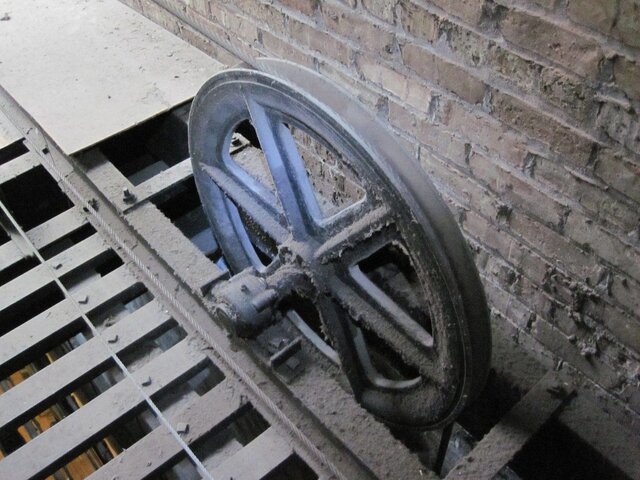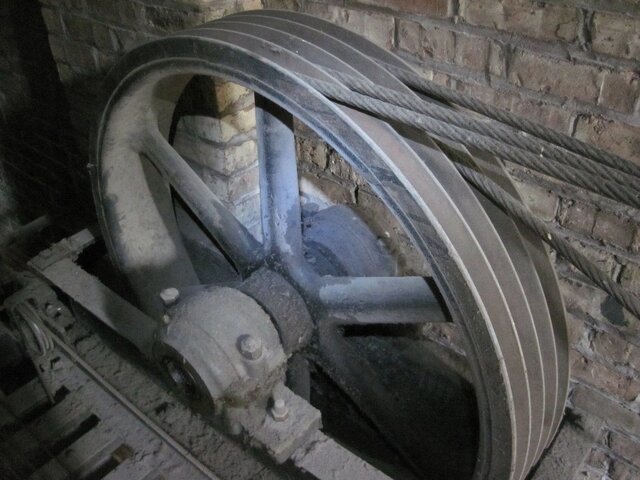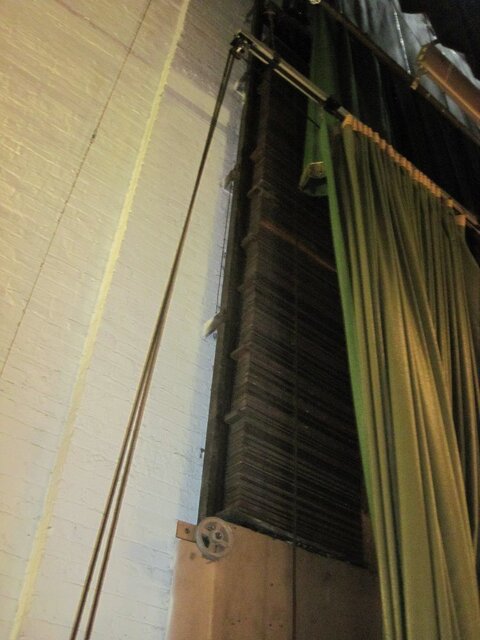You are using an out of date browser. It may not display this or other websites correctly.
You should upgrade or use an alternative browser.
You should upgrade or use an alternative browser.
Pull a non-fire curtain in a fire?
- Thread starterJay Ashworth
- Start date
BillConnerFASTC
Well-Known Member
techieman33
Well-Known Member
As I noted, the weight is the counterweight plus the drive. There may be a lot of math but in the end, its release and time, and add or remove some weight, until the decent is the desired or required speed.
The videod curtain clearly seems to have a dash pot or similar to slow at end of travel. A lot today simply govern the speed the whole way.
It does have a dash pot. My understanding was that you wanted it to slow down that few feet. That way it bought a little more time for someone to clear out from under it, and so that it had a softer landing on the stage itself. I can't find it now but there used to be a page on Clancys site that said a curtain should take ~15 seconds to drop to a few feet above the deck and then another 10 to actually come in contact with the deck.
Based on NFPA 80 and the ANSI standard there is no longer a overall time that the curtain must close by (use to be 30 seconds.) It's now based on feet per second. The speed must be no slower than 1 foot per second and the last 8' must take no less than 5 seconds. This allows for those ginormous framed curtains to move at a speed that won't be impossible to stop when it hits the deck.
BillConnerFASTC
Well-Known Member
techieman33
Well-Known Member
But most designed and installed today are motorized and simply governed at a constant speed, was my point.
So what happens if the building loses power and the fire curtain needs to come down?
BillConnerFASTC
Well-Known Member
Clutch being slightly more descriptive than brake but yes, the drive holds it up and than is disconnected for release.
With the removal of the requirement for fusible links, it will be interesting to see if the cut line goes away. Alarm style pull stations and heat detectors and wire in conduit. So long Rube Goldberg.
As to control and free fall, it bothers me there is no e-stop, no way to intervene if its a false trip and and someone or something is in the path.
With the removal of the requirement for fusible links, it will be interesting to see if the cut line goes away. Alarm style pull stations and heat detectors and wire in conduit. So long Rube Goldberg.
As to control and free fall, it bothers me there is no e-stop, no way to intervene if its a false trip and and someone or something is in the path.
Wouldn't an estop add a lot of complication to a system that should be pretty fool proof? And isn't the possibility of someone in the way the reason many slow down for the last part of the drop? I'd also argue that a large red estop plunger would attract the attention of someone even moderately excited about some sort of emergency on stage. I'd be worried someone trying to do the right thing would end up preventing the fire curtain from dropping when needed.
BillConnerFASTC
Well-Known Member
I'm just more worried about people getting injured and property damaged, which by anectdotal evidence has occurred, than I am worried it might not be all the way down in a fire, because there is no evidence I've seen that a fire safety curtain has ever prevented an injury or death from fire. Plus, just lowering the proscenium opening height could help, as it lowers the point smoke can roll into an audience because its further below the neutral pressure plane.
You worry about someone stopping it when they shouldn't, and I worry about someone starting it. A 5 ton plus fsc is going to be over 1000 pounds curtain heavy, so if you're under it, whether your crushed in 1 second or 3 seconds seems irrelevant, as you are crushed and no one could stop it.
Never forget these were invented to save property. Last one out closes it and when the stage burns down in the middle if the night, you save the auditorium. Well, once upon a time that was the case, when stage and auditorium were two separate buildings. Today, one going is going to destroy the other. We've forgotten the past.
You worry about someone stopping it when they shouldn't, and I worry about someone starting it. A 5 ton plus fsc is going to be over 1000 pounds curtain heavy, so if you're under it, whether your crushed in 1 second or 3 seconds seems irrelevant, as you are crushed and no one could stop it.
Never forget these were invented to save property. Last one out closes it and when the stage burns down in the middle if the night, you save the auditorium. Well, once upon a time that was the case, when stage and auditorium were two separate buildings. Today, one going is going to destroy the other. We've forgotten the past.
Last edited:
Speaking of anecdotal, one of the PAC's in our area has a curtain that deploys when the fire alarm activates, regardless of whether it was triggered by anything near the theatre or not. It is a fiberglass curtain, but has crushed and broken a few music stands in its lifetime and at least one incident with a student who was under it, watching it deploy without any clue as to what it was or why it was doing that.
I would wager in our age of safety and interlocks and e-stops, more people are inclined to think that machines in their environment (simple or otherwise) will at least stop before potentially maiming them.
I would wager in our age of safety and interlocks and e-stops, more people are inclined to think that machines in their environment (simple or otherwise) will at least stop before potentially maiming them.
Similar threads
- Replies
- 23
- Views
- 6K
- Replies
- 1
- Views
- 3K
Users who are viewing this thread
Total: 1 (members: 0, guests: 1)






